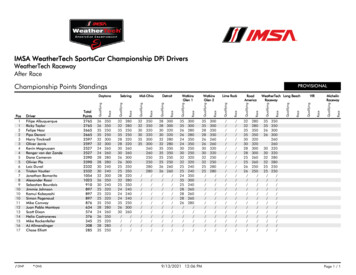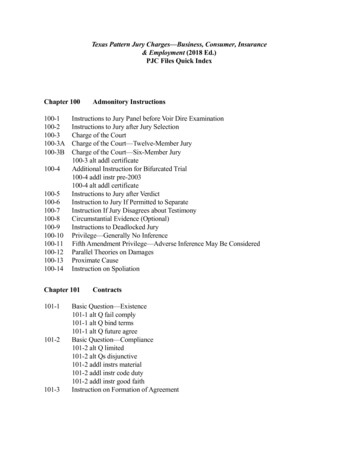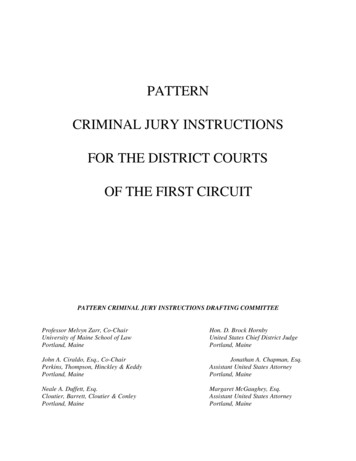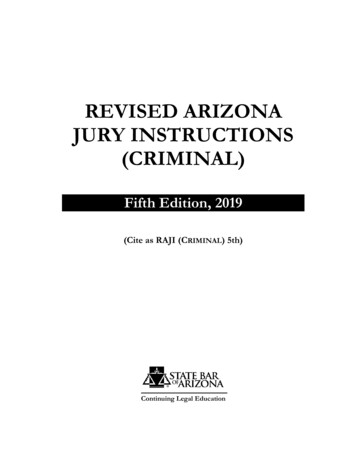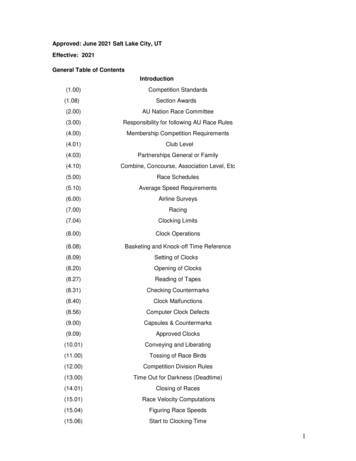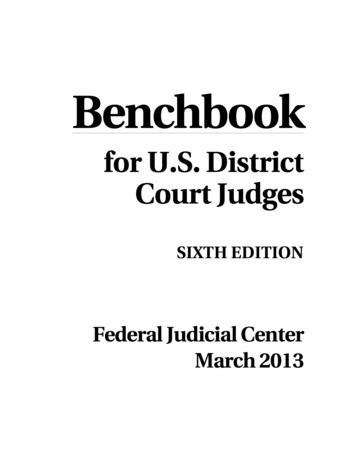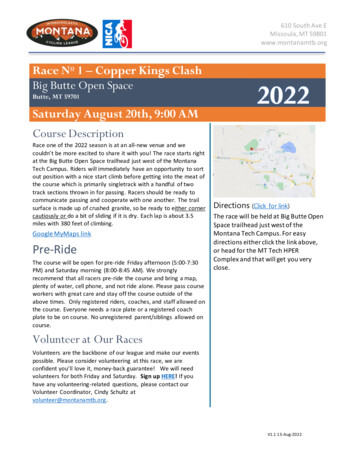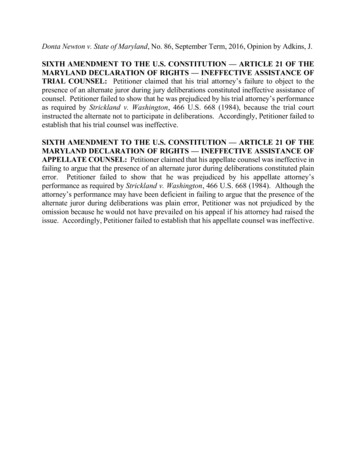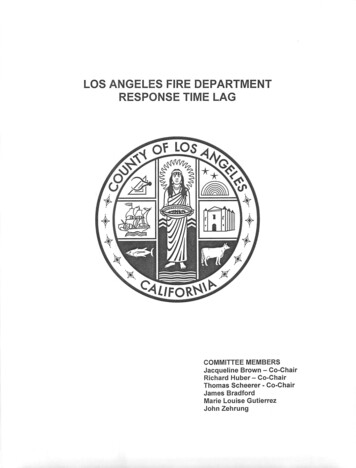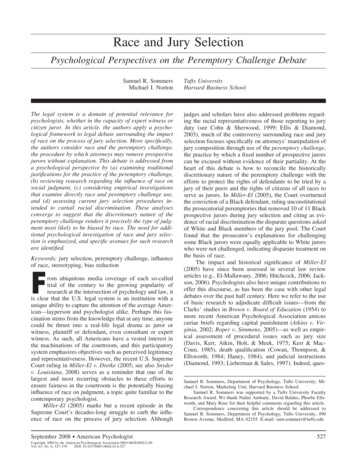
Transcription
Race and Jury SelectionPsychological Perspectives on the Peremptory Challenge DebateSamuel R. SommersMichael I. NortonThe legal system is a domain of potential relevance forpsychologists, whether in the capacity of expert witness orcitizen juror. In this article, the authors apply a psychological framework to legal debate surrounding the impactof race on the process of jury selection. More specifically,the authors consider race and the peremptory challenge,the procedure by which attorneys may remove prospectivejurors without explanation. This debate is addressed froma psychological perspective by (a) examining traditionaljustifications for the practice of the peremptory challenge,(b) reviewing research regarding the influence of race onsocial judgment, (c) considering empirical investigationsthat examine directly race and peremptory challenge use,and (d) assessing current jury selection procedures intended to curtail racial discrimination. These analysesconverge to suggest that the discretionary nature of theperemptory challenge renders it precisely the type of judgment most likely to be biased by race. The need for additional psychological investigation of race and jury selection is emphasized, and specific avenues for such researchare identified.Keywords: jury selection, peremptory challenge, influenceof race, stereotyping, bias reductionFrom ubiquitous media coverage of each so-calledtrial of the century to the growing popularity ofresearch at the intersection of psychology and law, itis clear that the U.S. legal system is an institution with aunique ability to capture the attention of the average American—layperson and psychologist alike. Perhaps this fascination stems from the knowledge that at any time, anyonecould be thrust into a real-life legal drama as juror orwitness, plaintiff or defendant, even consultant or expertwitness. As such, all Americans have a vested interest inthe machinations of the courtroom, and this participatorysystem emphasizes objectives such as perceived legitimacyand representativeness. However, the recent U.S. SupremeCourt ruling in Miller-El v. Dretke (2005; see also Snyderv. Louisiana, 2008) serves as a reminder that one of thelargest and most recurring obstacles to these efforts toensure fairness in the courtroom is the potentially biasinginfluence of race on judgment, a topic quite familiar to thecontemporary psychologist.Miller-El (2005) marks but a recent episode in theSupreme Court’s decades-long struggle to curb the influence of race on the process of jury selection. AlthoughSeptember 2008 American PsychologistCopyright 2008 by the American Psychological Association 0003-066X/08/ 12.00Vol. 63, No. 6, 527–539DOI: 10.1037/0003-066X.63.6.527Tufts UniversityHarvard Business Schooljudges and scholars have also addressed problems regarding the racial representativeness of those reporting to juryduty (see Cohn & Sherwood, 1999; Ellis & Diamond,2003), much of the controversy surrounding race and juryselection focuses specifically on attorneys’ manipulation ofjury composition through use of the peremptory challenge,the practice by which a fixed number of prospective jurorscan be excused without evidence of their partiality. At theheart of this debate is how to reconcile the historicallydiscretionary nature of the peremptory challenge with theefforts to protect the rights of defendants to be tried by ajury of their peers and the rights of citizens of all races toserve as jurors. In Miller-El (2005), the Court overturnedthe conviction of a Black defendant, ruling unconstitutionalthe prosecutorial peremptories that removed 10 of 11 Blackprospective jurors during jury selection and citing as evidence of racial discrimination the disparate questions askedof White and Black members of the jury pool. The Courtfound that the prosecutor’s explanations for challengingsome Black jurors were equally applicable to White jurorswho were not challenged, indicating disparate treatment onthe basis of race.The impact and historical significance of Miller-El(2005) have since been assessed in several law reviewarticles (e.g., El-Mallawany, 2006; Hitchcock, 2006; Jackson, 2006). Psychologists also have unique contributions tooffer this discourse, as has been the case with other legaldebates over the past half century. Here we refer to the useof basic research to adjudicate difficult issues—from theClarks’ studies in Brown v. Board of Education (1954) tomore recent American Psychological Association amicuscuriae briefs regarding capital punishment (Atkins v. Virginia, 2002; Roper v. Simmons, 2005)—as well as empirical assessment of procedural issues such as jury size(Davis, Kerr, Atkin, Holt, & Meek, 1975; Kerr & MacCoun, 1985), death qualification (Cowan, Thompson, &Ellsworth, 1984; Haney, 1984), and judicial instructions(Diamond, 1993; Lieberman & Sales, 1997). Indeed, quesSamuel R. Sommers, Department of Psychology, Tufts University; Michael I. Norton, Marketing Unit, Harvard Business School.Samuel R. Sommers was supported by a Tufts University FacultyResearch Award. We thank Nalini Ambady, David Baldus, Phoebe Ellsworth, and Mary Rose for their helpful comments regarding this article.Correspondence concerning this article should be addressed toSamuel R. Sommers, Department of Psychology, Tufts University, 490Boston Avenue, Medford, MA 02155. E-mail: sam.sommers@tufts.edu527
Samuel R.Sommerstions central to the race and jury selection controversy havebarely begun to be addressed empirically: To what extentdoes race influence jury selection judgments? Throughwhat psychological processes? How easy is it to identifythe impact of race on any particular peremptory challenge?Absent data on these and other important issues, it ispremature to offer concrete policy recommendations, butclearly psychological theory and findings regarding racialstereotyping and bias can inform this ongoing debate.Moreover, this controversy provides an instructive casestudy for psychologists with more basic interests in race,person perception, and social judgment.In the first section of this article, we review the historyof the peremptory challenge, examine its interaction withrace, and assess from a psychological perspective traditional justifications for the practice. We then examine thepsychological literature on race and social judgment, assessing the extent to which race likely influences peremptory use, as well as the difficulty inherent in identifyingsuch influence. Next, we consider the few empirical investigations that have examined directly the relationship between race and peremptory challenge use. Finally, weevaluate the viability of current safeguards against theinfluence of race during jury selection and consider optionsfor their improvement. Throughout the article, we identifyavenues for future research that will allow psychologists tooffer more substantive and specific contributions to thisdebate.The Story of the PeremptoryChallengeBackground and AssumptionsDuring jury selection, there are two routes through whichlitigants seek removal of prospective jurors. In a successful528challenge for cause, the judge is persuaded that a juror willnot be impartial and, thus, removes this individual from thejury panel. Such challenges are unlimited in number, butjudges are typically hesitant to accept them absent clearevidence of a fixed opinion that would preclude impartiality (Babcock, 1975; Baldus, Woodworth, Zuckerman,Weiner, & Broffitt, 2001; Hans & Vidmar, 1982). Thesecond option— often pursued after a failed challenge forcause—is to use one of a limited number of peremptorychallenges (sometimes referred to simply as peremptories),by which a prospective juror is excused without justification. Peremptories enjoy a long legal history, although theyare not guaranteed by the U.S. Constitution (Alschuler,1989; Broderick, 1992). The most common argument insupport of the practice is that it allows attorneys to removejurors whom they believe but cannot prove to be biased. Assuch, peremptories are presumed to create fair juries andreassure litigants that they have a say as to who judgesthem (Batson v. Kentucky, 1986; Hans & Vidmar, 1982).Babcock (1975) noted two additional benefits: preventingthe unpleasantness of articulating concerns about juror biasand enabling attorneys to remove jurors who have beenalienated by probing questions during jury selection, orvoir dire.Rarely have these alleged benefits been examinedempirically (Broderick, 1992). Do peremptories improvejury impartiality? The number of peremptories allowedvaries by state and type of case, yet no published analysescompare jury selection outcomes across courthouses, perhaps because of difficulties in operationalizing impartiality.More testable is the assumption that attorneys can accurately and consistently deduce a juror’s verdict predisposition—not to mention an inability to remain impartial—during voir dire. But few empirical studies support thatproposition: “An attorney’s ability to predict appears limited by a very low ceiling of precision” (Hastie, 1991, p.712; see also Finkelstein & Levin, 1997; Johnson & Haney,1994; Zeisel & Diamond, 1978). Data suggest that attorneys sometimes focus voir dire questions on indoctrinationas opposed to bias identification (Hastie, 1991), leavingthem ill-prepared to use peremptories. Moreover, jurorsfrequently conceal information during voir dire and areunable to assess their own impartiality (Kerr, Kramer,Carroll, & Alfini, 1991; Seltzer, Venuiti, & Lopes, 1991).In sum, although some attorneys may be better than othersat identifying biased jurors—and some biases may be easier to identify than others— data provide little evidence ofa reliable link between peremptory use and impartial juries.Some analyses even indicate that voir dire produces jurieswith attitudes no different from the attitudes of a group of12 randomly selected individuals (e.g., Johnson & Haney,1994).Other purported benefits of the peremptory challengehave also received scant empirical attention. Does theperemptory challenge provide a safeguard for attorneyswho wish to avoid empanelling jurors irritated by aggressive questioning? This proposition seems plausible, although Rose’s (2003) interviews with jurors indicate thatmany do not take personally either the questions they areSeptember 2008 American Psychologist
Michael I.Nortonasked during voir dire or the experience of being excusedfrom a jury. Do peremptories increase the perceived fairness of the system? General surveys could address thisquestion directly, but such studies have not been conducted. Relevant findings are reported by MacCoun andTyler (1988), who found that laypeople prefer juries tojudges and prefer 12-person juries to 6-person juries, inlarge part because of the greater community representativeness associated with larger juries. Combined with the finding that peremptory challenge use often creates less representative juries (see Baldus et al., 2001), this resultprovides indirect evidence that peremptories do not bolsterthe legitimacy of the legal system and can, in some cases,even undermine it. Overall, although the arguments infavor of peremptory challenges carry intuitive appeal, theyremain largely unexamined and, on some counts, inconsistent with empirical data.Peremptories and RaceThat the peremptory challenge might not live up to itsreputation for improving jury impartiality and system legitimacy is not as problematic as the allegation that thepractice also enables racial discrimination during jury selection. Indeed, the peremptory controversy centers onrace, although other criticisms include, for example, thatthe practice contributes to making voir dire a cumbersomeand inefficient process. Regarding the ostensible advantages of peremptories, these benefits seem even less likelyto be realized when challenges are based on race. First,race-based peremptories do not lead to more impartialjuries. To the contrary, both legal rulings and empiricaldata suggest that diverse jury compositions can reduce biasand encourage more thorough deliberations (Peters v. Kiff,1972; Sommers, 2006). Concerning legitimacy, juries thatSeptember 2008 American Psychologistare not racially representative of their communities tend toelicit skepticism rather than confidence in the system (Ellis& Diamond, 2003; Hans & Vidmar, 1982). And withregard to other advantages suggested by Babcock (1975),she has acknowledged that they are not applicable whenperemptories are based on race (Babcock, 1993).The Supreme Court has addressed the issue of raceand peremptories several times. As far back as in the 19thcentury, the Court ruled against statutes excluding members of particular racial groups from jury duty (Neal v.Delaware, 1880; Strauder v. West Virginia, 1879) whileseparately affirming the importance of peremptories in juryselection (Lewis v. U.S., 1892; Pointer v. U.S., 1894). Thefirst case in which race and peremptory use intersected wasSwain v. Alabama (1965). The appeal of Robert Swain, aBlack man convicted of murder and sentenced to death byan all-White jury, was based on the exclusion of all sixBlack prospective jurors by prosecutorial peremptories.The Court ruled that these challenges were constitutional,as it should be presumed that attorneys have legitimatereason for peremptories in any given case and, in the wakeof unnecessary restrictions, “the challenge, pro tanto,would no longer be peremptory” (Swain, 1965, p. 222). Themajority conceded that more systematic efforts to excludemembers of a racial group from jury service across severaltrials would constitute a violation of equal protectionrights, but demonstrating that such bias had occurredproved to be impossible. In denying Swain’s appeal, forinstance, the Court majority was not swayed by the fact thatno Black individual had ever survived voir dire to serve asjuror on a criminal or civil jury in Talladega County, aregion with a Black population of 26%.Twenty years later, the Court’s ruling in Batson v.Kentucky (1986) eased this unattainable standard, markinga significant change in thinking since Swain (1965). Withthis ruling, the Court majority served notice that the prevention of racial discrimination now trumped the historicalsanctity of the peremptory challenge. Per Batson, a defenseattorney simply has to make a reasonable argument thatrace influenced prosecutorial peremptory use in the case athand—not systematically across cases— before the burdenshifts to the prosecution to prove otherwise. Batson was alandmark ruling in that for the first time, attorneys could beasked to justify peremptories. This first meaningful restriction on the peremptory challenge has since been extendedto defense attorneys (Georgia v. McCollum, 1992), civiltrials (Edmonson v. Leesville Concrete Co., 1991), andtrials in which the defendant and juror are not of the samerace (Powers v. Ohio, 1991). The Batson ruling was alsonoteworthy in that it singled out race as a characteristic onwhich peremptories could not be based. Subsequent defendants have appealed on the grounds that peremptories wereused to target jurors of other demographics, but the Courtgenerally has upheld only those appeals based on gender(J. E. B. v. Alabama, 1994).As monumental as it was, Batson (1986) left manyquestions unanswered, most notably how exactly judgesare supposed to evaluate the legitimacy of peremptories.Some subsequent decisions have rendered it more difficult529
to show that a peremptory challenge is based on race, suchas the ruling that to comply with Batson, an attorney mustsimply provide any race-neutral justification and not necessarily one that is “persuasive or even plausible” (Purkettv. Elem, 1995, p. 768). Other rulings, such as Miller-El(2005), suggest criteria for evaluating peremptory challenge justifications, but there remains no clear standard bywhich judges are to make this determination. Consistentwith such ambiguity, archival analysis indicates that Batson and its progeny have had little effect on actual peremptory challenge use or jury racial composition (Baldus et al.,2001). Consider, for example, pre-Hurricane Katrina Jefferson Parish, Louisiana, where, despite a Black populationof 23% according to the 2000 census, only 4% of jurors inpost-Batson capital murder trials have been Black (Liptak,2007). Of course, race-based peremptory use is not the onlyexplanation for data such as these: Large numbers of racialminority group members are eliminated from jury servicebefore even reaching the courthouse because of racial andsocioeconomic disparities in jury summons refusals, undeliverable jury summonses, and financial hardships that preclude jury service (see Ellis & Diamond, 2003). Still, thecontinuing problem of nonrepresentative juries in the wakeof Batson have led some to resurrect the call to eliminateperemptories found in Justice Thurgood Marshall’s concurring opinion: “Eliminating the shameful practice of racial discrimination in the selection of juries . . . can beaccomplished only by eliminating peremptory challengesentirely” (Batson, 1986, pp. 102–103).Clearly, many issues surrounding race and jury selection remain unresolved, and we believe that psychologistsare uniquely equipped to inform this ongoing debate. Forexample, rulings from Swain (1965) through Miller-El(2005) imply that race affects peremptory challenge use insome cases, but what does the psychological literature onrace and social judgment suggest regarding the pervasiveness and nature of this influence? If race impacts peremptory challenge use, what is the likelihood that self-reportedjustifications for such challenges will reveal this influence?That is, to what extent are attorneys unaware of the influence of race on their judgment, and, even when they areaware of it, how easy is it for them to come up withrace-neutral justifications? These are issues to which wenow turn our attention.Race and Social JudgmentInfluence of Social Category InformationIt is well documented that social category information suchas race can have profound effects on judgment (for areview, see Fiske, 1998). The impact of race has beendemonstrated in countless settings: medical diagnoses (e.g.,LaVeist, Arthur, Morgan, Plantholt, & Rubinstein, 2003),Diagnostic and Statistical Manual of Mental Disordersevaluations (e.g., Neighbors, Trierweiler, Ford, & Muroff,2003), ratings of professors (e.g., Vescio & Biernat, 1999),assessments of students (e.g., Staiger, 2004), perceptions ofpolitical candidates (e.g., Sigelman, Sigelman, Walkosz, &Nitz, 1995), and evaluations of job applicants (e.g., Ber530trand & Mullainathan, 2004), to name a few. Researchershave also examined the effects of race on legal judgment,with much of this work focusing on the influence of adefendant’s race on jurors (see Sommers, 2007). Findingsfrom these varied domains suggest not only that the influence of race on perception and judgment is pervasive butalso that it is often automatic (Devine, 1989; Fiske &Neuberg, 1990) and very quick (see Eberhardt, 2005; Ito &Urland, 2003).Through what processes does race affect social judgment? Two common answers in the psychological literatureinvolve cognition (i.e., stereotypes) and motivation or affect (i.e., prejudice), explanations that are not mutuallyexclusive. In examining these possibilities in the domain ofjury selection, it is important to consider how they interactwith attorneys’ primary goal of empanelling a favorablejury that increases their likelihood of winning the case.After all, although explicit purposes of voir dire includeempanelling an impartial and representative jury, the U.S.legal system is adversarial by nature. In practice, attorneys’chief objective in this process is to select jurors whom theybelieve will be sympathetic to their side of the case (Hans& Vidmar, 1982).Although we know of no direct empirical assessmentof the relationship, ample theoretical and anecdotal evidence suggests that attorneys’ stereotypes regarding jurorsof different races contribute to the impact of race on juryselection. As Fiske (1998) described, people tend to rapidlycategorize others on salient dimensions such as race. Thiscategorization is often accompanied by stereotypic associations that affect perception and judgment, and such stereotype activation is not always conscious. Colloquial useof the word stereotypes connotes exaggerated and negatively valenced beliefs about an outgroup, but stereotypesneed not be negative— or inaccurate—to influence judgment. Simply believing that members of a group are likelyto possess certain characteristics or attitudes is typicallysufficient to affect judgment and bring about confirmatoryinformation search processes (Darley & Gross, 1983; Snyder & Swann, 1978).There is little reason to suspect that legal judgmentsare immune from this influence of category-based beliefs.Stereotypes are particularly likely to affect judgments thatare based on limited information, made under cognitiveload, and hurried by time pressure (e.g., Kruglanski &Freund, 1983; Kunda, Davies, Adams, & Spencer, 2002;van Knippenberg, Dijksterhuis, & Vermeulen, 1999), allapt descriptions of typical voir dire. Indeed, jury selectionguides, training manuals, and other sources of jury folkloreinclude countless strategies based on explicit stereotypes:Defense attorneys should seek female jurors unless thedefendant is an attractive woman; poor jurors are good forthe defense in a civil case because they are uncomfortablewith large sums of money; civil plaintiffs should avoidjurors with professions based on precision, such as banktellers or accountants (Fulero & Penrod, 1990; Olczak,Kaplan, & Penrod, 1991). In the pursuit of a favorable jury,there appears to exist among attorneys a “time-honoredstratagem of selecting jurors by way of superstition, steSeptember 2008 American Psychologist
reotypes, body language, implicit theories of attitude andpersonality” (Kovera, Dickinson, & Cutler, 2002, p. 165)as well as other “seat-of-the-pants” intuitions (Broderick,1992, p. 410).It is clear that comparable juror stereotypes exist forrace (Page, 2005). Many jury selection manuals includeexplicit instructions to consider race. Justice Breyer’s opinion in Miller-El (2005) summarized some of these racialstereotypes, ranging from the general belief that Blackjurors are sympathetic toward civil plaintiffs to point-basedstrategies by which value is allocated to prospective jurorson the basis of race. Baldus et al. (2001) provided anotherexample, describing a training video for prosecutors thatcited race in describing “good” and “bad” jurors. Suchjuror stereotypes may also exert influence through nonconscious processes. To the extent that attorneys have beenexposed to or have developed their own racial stereotypesrelevant to juror performance—Blacks are skeptical ofpolice; Whites are forgiving of corporate malfeasance—noconscious effort may be necessary for these stereotypes toinfluence voir dire evaluations.A provocative issue in considering juror stereotypes isthat some of these assumptions about race may be accurate.Research suggests, for instance, that Black jurors are oftenmore lenient toward Black defendants than are White jurors(see T. W. Brewer, 2004; Mitchell, Haw, Pfeifer, & Meissner, 2005; Sommers, 2007). One might therefore argue thatit is rational for attorneys to consider race given their desireto select a sympathetic jury. However, whereas juror stereotypes tend to be global—Black jurors will not convictBlack defendants—research suggests that actual effects byjuror race are more context dependent. For example, whentrial evidence is strong, non-White jurors are often morepunitive toward ingroup versus outgroup defendants (Kerr,Hymes, Anderson, & Weathers, 1995; Taylor & Hosch,2004). Moreover, to the extent that between-race differences in juror tendencies derive from variability in experience and ideology (e.g., Cowan et al., 1984), attorneys maybe better served assessing these directly instead of relyingon race as a proxy. Of course, from a practical standpoint,these issues are moot, as the Supreme Court has deemedrace-based peremptories unconstitutional regardless of theaccuracy underlying them.What about affective or motivational processes? Doesracial prejudice among attorneys predict race-based peremptory challenge use? To answer this question, we firstpropose that the race-related stereotypes that influence juryselection are likely not the same stereotypes that psychologists typically associate with racial prejudice, such asthose regarding lack of intelligence, morality, or humanity.Rather, research on juror folklore implies that the influenceof race on jury selection often derives from attorneys’domain-specific beliefs about the tendencies of jurors ofdifferent races: Blacks are acquittal prone; racial minorityjurors are lenient toward same-race defendants. To ourknowledge, however, no studies have examined the linkbetween attorney endorsement of race-related juror stereotypes and peremptory challenge use during jury selection,September 2008 American Psychologistand the precise nature of this relationship remains speculative.More generally, psychological research has demonstrated that prejudice often leads decision makers to judgeless favorably and allocate fewer resources to particularoutgroups (for a review, see M. B. Brewer & Brown,1998). In contemporary America, such preferences may notbe as overt as they were in previous eras (e.g., Dovidio &Gaertner, 1998; Kinder & Sears, 1981), but they are notuncommon. At the same time, affect and attitudes towardoutgroup members—like stereotypic beliefs—are not always negative. Laypeople feel greater warmth toward certain racial groups than others (Fiske, Cuddy, Glick, & Xu,2002), and the perceived acceptability of prejudice alsovaries by target group (Crandall, Eshelman, & O’Brien,2002). Indeed, an emerging body of research suggests thatoutgroup membership can sometimes have positive effectson perceivers’ judgments (e.g., Barden, Maddux, Petty, &Brewer, 2004; Wittenbrink, Judd, & Park, 2001). For example, some Whites process persuasive arguments moresystematically when conveyed by a Black source (Petty,Fleming, & White, 1999; White & Harkins, 1994) or abouta Black target (Sargent & Bradfield, 2004), findings attributed to motivations to avoid prejudice. In the context ofjury selection, however, no research has examined whethersuch prejudice-related affect or motivation—in either conscious or nonconscious form—impacts judgments, despitethe testability of these relationships.One could argue that such race-related motivations areunlikely to gain traction in attorneys’ jury selection judgments unless they also facilitate the effort to empanel afavorable jury. As with any walk of life, certainly there areattorneys who harbor animosity toward particular racialgroups, but does such sentiment affect peremptory challenge use? Consider, for example, archival data indicatingthat prosecuting and defense attorneys are often mirroropposites in their use of peremptory challenges (e.g.,Turner, Lovell, Young, & Denny, 1986): In cases withBlack defendants, prosecutors tend to challenge Black prospective jurors and defense attorneys tend to challengeWhite prospective jurors. The most parsimonious and intuitive explanation for this finding would not be that prosecutors harbor anti-Black prejudice—and thereby seek todeprive Black citizens of their rights to serve as jurors—whereas defense attorneys hold comparable antipathy toward Whites. More plausible is an account that focuses onstereotypes concerning which jurors are likely to be favorable to each side of the case. To the extent that prejudicedoes impact peremptory challenge use, it seems likely thatthese effects are less overt, such as leading attorneys toperceive less rapport with certain jurors during voir dire orpredicting a tendency to view outgroup jurors as homogeneous. Of course, these are empirical questions.In sum, our review of the psychological research hasillustrated that race has pervasive effects on judgmentsacross domains. Such influence seems particularly likely tooccur in a jury selection process that provides decisionmakers with a limited amount of individuating informationabout jurors and actually champions the use of category531
based assumptions. However, researchers have not examined directly the link between attorneys’ race-related jurorstereotypes and their jury selection tendencies, nor hasresearch explored the relationship between attorney prejudice and peremptory challenge use. The specific psychological mechanisms by which race impacts jury selectiontherefore remain uncertain, as does the extent to whichsuch influence is based on conscious versus nonconsciousprocesses.Identifying the Influence of RaceBasic research not only indicates that the influence of raceon social judgment is widespread and occurs through multiple processes but also that this influence is difficult toidentify in any one instance (see Norton, Sommers, Vandello, & Darley, 2006). Particularly problematic are attempts to assess such influence using self-report data, ascourts do in the wake of Batson (1986). One limitation ofself-report data is the potential for the effects of race tooccur outside conscious awareness, as detailed above. If adecision maker is not aware of the impact of race on adecision, he or she obviously cannot cite race as being aninfluential factor. Complicating matters further is people’swell-documented tendency to offer compelling explanations for behavior even when they are unaware of thefactors that were influential (Nisbett & Wilson, 1977;Shafir, Simonson, & Tversky, 1993). To the extent that raceaffects judgment in an implicit, nonconscious manner, efforts to identify this influence via self-report are at bestuninformative and at worst misleading (Page, 2005).However, even if some attorneys consciously cons
psychologists, whether in the capacity of expert witness or citizen juror. In this article, the authors apply a psycho-logical framework to legal debate surrounding the impact . voir dire at which each juror was questionedÑas race-neutral considerations that could have been inßuential. If the Miller-El opinions offer a Þrm conclusion, it .
